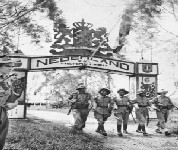 Dutch New Guinea becomes involved in World War II in 1942. On 7 December 1941, Japan attacks several targets simultaneously. The best known is the attack on Pearl Harbour (Hawai), in which the American fleet was severely damaged. The Japanese invasion of Australian and Dutch New Guinea lasts from November 1941 until April 1942. The take-over happens in record time because there are very few battalions of the Royal Dutch Army in the East Indies (KNIL) in New Guinea at the time. The Japanese advance from the north in the direction of Australia. The FAk Fak is taken over by the Japanese on 1 April 1942, Manakwari on 12 April and Hollandia on 20 April.
Dutch New Guinea becomes involved in World War II in 1942. On 7 December 1941, Japan attacks several targets simultaneously. The best known is the attack on Pearl Harbour (Hawai), in which the American fleet was severely damaged. The Japanese invasion of Australian and Dutch New Guinea lasts from November 1941 until April 1942. The take-over happens in record time because there are very few battalions of the Royal Dutch Army in the East Indies (KNIL) in New Guinea at the time. The Japanese advance from the north in the direction of Australia. The FAk Fak is taken over by the Japanese on 1 April 1942, Manakwari on 12 April and Hollandia on 20 April. 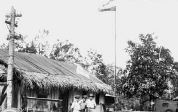 After the occupation of New Guinea, Japan plans to go across to Australia but they do not get any further than Frederik Hendrik Island. The Japanese do not attach any importance to Merauke on the south east coast. This settlement is the only unoccupied territory for the duration of the war, and the Dutch flag continues to fly here.
After the occupation of New Guinea, Japan plans to go across to Australia but they do not get any further than Frederik Hendrik Island. The Japanese do not attach any importance to Merauke on the south east coast. This settlement is the only unoccupied territory for the duration of the war, and the Dutch flag continues to fly here.
Contents
1. War breaks out in South East Asia
2. Liberating New Guinea
3. Manokwari Army sinks ship
4. Mollucan girl joins guerrilla army
5. Turning point of the war in Asia
6. Invasion of Hollandia
7. The battle of Biak
8. Squadron in Merauke gets bored
9. Japanese commander fights from jungle
10. Links
11. Sources
1.War breaks out in South East Asia
In July 1941 the Japanese government decides that South East Asia should become a part of the Greater East Asia Co-Prosperity Sphere. The main aim really is to take control of all 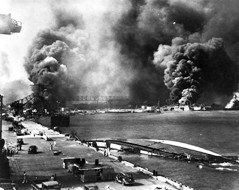 the resources and commodities (such as oil and rubber) within the English and Dutch colonies.
the resources and commodities (such as oil and rubber) within the English and Dutch colonies.
Japan attacks the American Fleet in Pearl Harbour on 7 December 1941. The war has now spread to South East Asia. The Dutch government in London declares war on Japan. All men of the Dutch East Indies, who are between sixteen and sixty years of age, are called to take up arms. The Japanese advance swiftly, totally invading the Dutch colony. The Dutch military capitulate on 8 March 1942. Secret military operations are organised in the Dutch East Indies from Australia by the military who went there when they had to surrender. They form small groups (Party groups) who return to the Dutch East Indies and New Guinea in order to gather strategic information about the Japanese. A total of ten such groups were dropped into New Guinea behind the Japanese lines in order to conduct espionage operations.
After bombing the Australian harbour of Darwin in 1942, the Japanese move their headquarters to 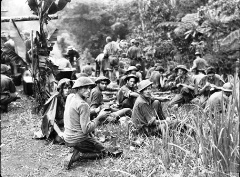 Buna on the north coast of what is now Papua New Guinea and the headquarters of the Allies is set up in Port Moresby on the other side. These towns are divided by the steep Owen Stanley mountain range. The two towns are connected by the Kokoda track across the mountains.
Buna on the north coast of what is now Papua New Guinea and the headquarters of the Allies is set up in Port Moresby on the other side. These towns are divided by the steep Owen Stanley mountain range. The two towns are connected by the Kokoda track across the mountains. 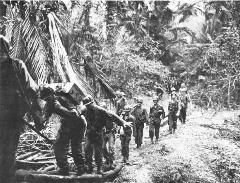 Australian troops successfully defend Port Moresby along this trail, when the Japanese try to invade from the north coast. To get the advantage, the Australian carved out 4000 steps into the mountain side.
Australian troops successfully defend Port Moresby along this trail, when the Japanese try to invade from the north coast. To get the advantage, the Australian carved out 4000 steps into the mountain side.
The American army lands on New Guinea in January 1943 and starts a major attack. However, it takes up until 1944 before the Americans can advance along the northern coast of New Guinea from Hollandia to Biak and Manokwari and on to the North Moluccas (Morotai) from where they attack the Philippines in October 1944. In order to recapture New Guinea, the Allied Forces need to drive the Japanese off along 2000 km of fortified coast line. During this battle 13000 Japanese soldiers die and on the Australian and American side there are respectively 2100 and 2000 casualties.
On 12 April 1942, the japans arrive at Doré Baai in Manokwari, situated to the north of the Vogelkop area. There are only aboy 150 Dutch military stationed here with their leader Captain J.B.H Wileemsz 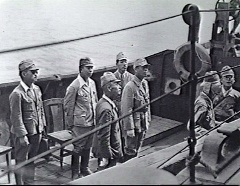 Geeroms. The commanders realises that they are outnumbered and they decide to sink their only ship by putting it on fire, keeping it out of the hands of the enemy. After several bombing raids on Manakwari, it is captured and the Japanese set up a considerable army at this location. All the Europeans are taken off and interned on Ambon. However, some of the Dutch infantry(KNIL), 62 Dutch soldiers and 17 indigenous Papuans (Meja-Arfakkers), disappear into the jungle and for the remainder of the war they organise guerrilla warfare against the Japanese. On 1 April 1943 the Japanese invade the headquarters of the guerrilla fighters and
Geeroms. The commanders realises that they are outnumbered and they decide to sink their only ship by putting it on fire, keeping it out of the hands of the enemy. After several bombing raids on Manakwari, it is captured and the Japanese set up a considerable army at this location. All the Europeans are taken off and interned on Ambon. However, some of the Dutch infantry(KNIL), 62 Dutch soldiers and 17 indigenous Papuans (Meja-Arfakkers), disappear into the jungle and for the remainder of the war they organise guerrilla warfare against the Japanese. On 1 April 1943 the Japanese invade the headquarters of the guerrilla fighters and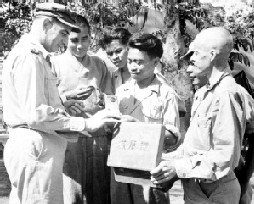 their commander Willemsz Geerom is captured and executed in Manokwari at a later date. Sergeant Mauritz Christiaan Kokkelink takes over the leadership. On 18 April 1944 the guerrilla group, by then consisting of only 35 men, attacks the Japanese base in Manokwari. Just about every one present is killed. The American counter attack starts on 9 May 1944 and Manokwari is turned to rubble because of intensive bombardments. Only three houses actually remain standing. The Japanese are chased out and many escape into the jungle, where most of them are killed off by the Papuans.
their commander Willemsz Geerom is captured and executed in Manokwari at a later date. Sergeant Mauritz Christiaan Kokkelink takes over the leadership. On 18 April 1944 the guerrilla group, by then consisting of only 35 men, attacks the Japanese base in Manokwari. Just about every one present is killed. The American counter attack starts on 9 May 1944 and Manokwari is turned to rubble because of intensive bombardments. Only three houses actually remain standing. The Japanese are chased out and many escape into the jungle, where most of them are killed off by the Papuans.
4. Moluccan girl joins guerrilla group
The Moluccan group in the jungle of the Vogelkop consists of four fighting units and is the only one that manages to keep going right up until liberation. They score a number of successes but also suffer 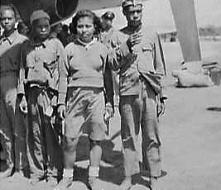 defeat. Together with the help of local Papuans, the guerrilla fighters collect information about the enemy and they attack Japanese patrols. A fifteen year-old girl, Coosje Ayal joins the group together with her aunt and uncle. The men tell her : We’ll not treat you like a girl, but like a soldier. If you accept that, you can stay”.
defeat. Together with the help of local Papuans, the guerrilla fighters collect information about the enemy and they attack Japanese patrols. A fifteen year-old girl, Coosje Ayal joins the group together with her aunt and uncle. The men tell her : We’ll not treat you like a girl, but like a soldier. If you accept that, you can stay”.
“ We kept tracking through the jungle with our gun and heavy packs. The last months were the worst; we ate snakes, crocodiles and turtles.”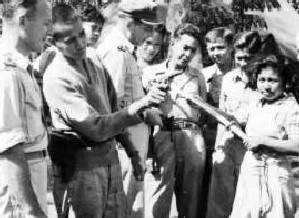
The guerrilla group keeps up the fight , they kill 30 or more Japanese and make contact with the Allied Forces in October 1944, when they are liberated. Of the original 62 men, only 14 survive. After being liberated, they embroider their names on the Dutch flag which Koosje carried with her and sent this to Queen Wilhelmina. It also has the following text on it: As you will know, the unit at Manokwari never surrendered!
Apart from Willemsz Geerom’s Group, the other groups involved in action are: the resistance group by J.V.de Bruyn, the Austalian Crayfish party and Oaktree party and a group led by Jan van Echoud, who got information for the Americans and whose work was known as ‘Operation Bulldozer’. Not much is known about the history of these groups.
5. The turning point of the war
The battle at Midway is the turning point of the war. Near this atoll in the Pacific , the Americans achieve a convincing victory from which the Japanese Marine will not recover. The secret weapon of the 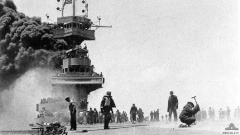 Americans come in the form of the Americans of Japanese origin : The Isei ( Americans born in Japan). The Nisei( Americans with Japanese parents) and the Kisei (born in the US but grown up in Japan). The Americans manage to crack the communication code of the Japanese Marine Force so that they have the advantage. The Japanese loose four aircraft carriers and many of their aircraft. The amphibian assault on Port Moresby is prevented because of the Battle of the Coral Sea in May 1942, even though it is tactically a defeat for
Americans come in the form of the Americans of Japanese origin : The Isei ( Americans born in Japan). The Nisei( Americans with Japanese parents) and the Kisei (born in the US but grown up in Japan). The Americans manage to crack the communication code of the Japanese Marine Force so that they have the advantage. The Japanese loose four aircraft carriers and many of their aircraft. The amphibian assault on Port Moresby is prevented because of the Battle of the Coral Sea in May 1942, even though it is tactically a defeat for 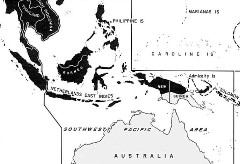 the Americans. For the very first time a Japanese landing fails. This occurs at the mini battle at Milne Bay in August of 1942. At this same point in time, American as well as Japanese soldiers try to occupy Guandalcanal Island, which is one of the Solomon Islands. The horrific battle which lasts for the next six months, and which takes 40.000 lives, eventually leads to an American victory. After this, Japan is definitely on the defensive. The ongoing necessity to send reinforcements to Guadalcanal, weakens the Japanese effort elsewhere. In 1943, this leads to the recapture of strategic positions in Buna and Gona on New Guinea by Australian and American troops.
the Americans. For the very first time a Japanese landing fails. This occurs at the mini battle at Milne Bay in August of 1942. At this same point in time, American as well as Japanese soldiers try to occupy Guandalcanal Island, which is one of the Solomon Islands. The horrific battle which lasts for the next six months, and which takes 40.000 lives, eventually leads to an American victory. After this, Japan is definitely on the defensive. The ongoing necessity to send reinforcements to Guadalcanal, weakens the Japanese effort elsewhere. In 1943, this leads to the recapture of strategic positions in Buna and Gona on New Guinea by Australian and American troops.
The Americans make their first landing within Dutch occupied territory, near Hollandia and at 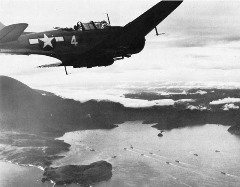 Tanamerah Bay to the west, in April 1944 (Operations Reckless and Persecution). Prior to this an American submarine destroyed Japanese ships, which were on their way from the Pullau island to Hollandia with the latest military arsenal on board. With this attack a whole Japanese regiment went down, along with numerous tanks, armoured vehicles and other equipment. From 21 to 27 April, the Americans carry out amphibious landings in order to take over Hollandia and landing strips at Sentani. These attacks went under the name of "Operation Reckless 'and 'Operation Persecution’ and were part of the ‘New
Tanamerah Bay to the west, in April 1944 (Operations Reckless and Persecution). Prior to this an American submarine destroyed Japanese ships, which were on their way from the Pullau island to Hollandia with the latest military arsenal on board. With this attack a whole Japanese regiment went down, along with numerous tanks, armoured vehicles and other equipment. From 21 to 27 April, the Americans carry out amphibious landings in order to take over Hollandia and landing strips at Sentani. These attacks went under the name of "Operation Reckless 'and 'Operation Persecution’ and were part of the ‘New Guinea Campaign’ Near Hollandia, where there is a big Japanese supply base, the Americans set up the Head Quarters of the Pacific region in record time. This is constructed on Mount Ifar, at the foot of the Cycloop Mountains. At this spot the five star general Douglas MacArthur comes up with his strategy for the land route across New Guinea as well as the island-hopping campaign for Admiral Chester Nimitz across the Pacific Ocean. During a big army round-up at Sentani, some 800 Japanese are killed. For many Papuans this period of time is their first encounter with military violence of the 20th century.
Guinea Campaign’ Near Hollandia, where there is a big Japanese supply base, the Americans set up the Head Quarters of the Pacific region in record time. This is constructed on Mount Ifar, at the foot of the Cycloop Mountains. At this spot the five star general Douglas MacArthur comes up with his strategy for the land route across New Guinea as well as the island-hopping campaign for Admiral Chester Nimitz across the Pacific Ocean. During a big army round-up at Sentani, some 800 Japanese are killed. For many Papuans this period of time is their first encounter with military violence of the 20th century.
The Japanese take over the northern entry to the Geelvink Bay in the island of Biak on 25 December 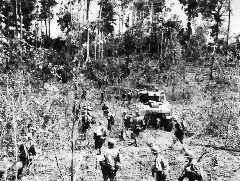 1943. The 222nd infantry detachment of the Japanese build three landing strips at Sorido, along the south coast of Biak in order to defend the island. From 27 May to 20 June 1944 the Americans fight against the Japanese who have entrenched themselves and are using delay tactics for the first time. The island is being occupied by 11.000 Japanese soldiers under the command of colonel Kuzume Naoyuki. He decided to let the Americans come ashore without resistance, after which he lures them into an ambush near the airport of
1943. The 222nd infantry detachment of the Japanese build three landing strips at Sorido, along the south coast of Biak in order to defend the island. From 27 May to 20 June 1944 the Americans fight against the Japanese who have entrenched themselves and are using delay tactics for the first time. The island is being occupied by 11.000 Japanese soldiers under the command of colonel Kuzume Naoyuki. He decided to let the Americans come ashore without resistance, after which he lures them into an ambush near the airport of 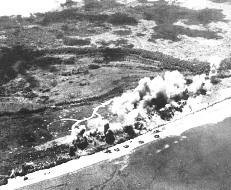 Mokmer. This area is full of caves and bunkers, an ideal place to hide snipers with automatic rifles, artillery guns, batteries of mortars and light tanks. When the Americans land at Bosnek on East Biak and then move into the interior, they do not expect much resistance. But at Mokmer many lives and vital equipment are lost. The American Air Force needs to provide extra assistance with bombardments for weeks on end. In July the eventual balance is as follows: 6100 Japanese are dead and 459 of them have been captured against 474 deaths and 2400 wounded on the American side.
Mokmer. This area is full of caves and bunkers, an ideal place to hide snipers with automatic rifles, artillery guns, batteries of mortars and light tanks. When the Americans land at Bosnek on East Biak and then move into the interior, they do not expect much resistance. But at Mokmer many lives and vital equipment are lost. The American Air Force needs to provide extra assistance with bombardments for weeks on end. In July the eventual balance is as follows: 6100 Japanese are dead and 459 of them have been captured against 474 deaths and 2400 wounded on the American side.
8. Squadron 120 in Merauke gets bored
Even though Merauke is never occupied by the Japanese, it does also suffer from the war. in 1941 and  1943 the settlement on the south near the border with PNG is frequently bombarded by Japanese planes. Squadron 120 of the Dutch East Indies’ Air Force (a section of ML-KNIL) arrive in the Spring of 1944, replacing and Australian squadron. The fifty pilots of Squadron 120 are all Indo-Europeans who defected to Australia when the war started. They are used for reconnaissance and are supposed to bombard Japanese positions along the coast. Because the war is drawing to an end, there is not that much action anymore and boredom takes over. Whenever they shoot a pig, there
1943 the settlement on the south near the border with PNG is frequently bombarded by Japanese planes. Squadron 120 of the Dutch East Indies’ Air Force (a section of ML-KNIL) arrive in the Spring of 1944, replacing and Australian squadron. The fifty pilots of Squadron 120 are all Indo-Europeans who defected to Australia when the war started. They are used for reconnaissance and are supposed to bombard Japanese positions along the coast. Because the war is drawing to an end, there is not that much action anymore and boredom takes over. Whenever they shoot a pig, there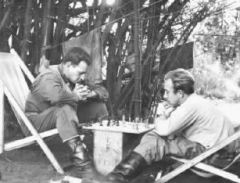 is a big party. The pilots hardly have any contact with the local population because not many Papuans in this region speak Malay. In June 1945 the squadron leaves for Biak where it is deployed in ‘Mopping-up’ operations, making an end to the last of any Japanese resistance. The hope arises among the pilots that they will be able to liberate the Dutch East Indies, but at the Head Quarters of the Allied Forces this is not a consideration.
is a big party. The pilots hardly have any contact with the local population because not many Papuans in this region speak Malay. In June 1945 the squadron leaves for Biak where it is deployed in ‘Mopping-up’ operations, making an end to the last of any Japanese resistance. The hope arises among the pilots that they will be able to liberate the Dutch East Indies, but at the Head Quarters of the Allied Forces this is not a consideration.
During the deployment at Merauke and later on Biak, the squadron looses a total of 12 pilots.
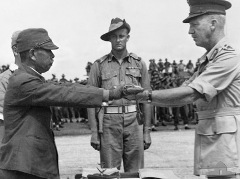 9. Japanese commander fights from jungle
9. Japanese commander fights from jungle
In August 1944 the commander Hatazo Adachi of the 18th Army division withdraws together with his battalion into the jungle after the landing of the American troops in Aitape and Hollandia between 22 and 27 April of that same year. Near Wewak on the north coast they become trapped and Adachi surrenders on 13 September 1945 to the Australian 6th Division. After a Court Martial has given him a life sentence, he commits suicide in Rabaul on 10 September 1947.
The battle in the Gulf of Leyte in the Philippines is from 23 to 26 October 1944. The Japanese try to stop the Allied Invasion and destroy them but i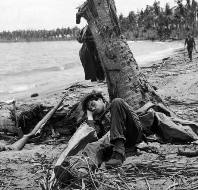 nstead the Allied Marines totally defeat the numerically weaker Japanese Naval Army. This battle is often regarded as one of the biggest naval battles in history. Thus this was an important victory and along with the battle at Midway, it spelled the beginning of the end for the Japanese invasion.
nstead the Allied Marines totally defeat the numerically weaker Japanese Naval Army. This battle is often regarded as one of the biggest naval battles in history. Thus this was an important victory and along with the battle at Midway, it spelled the beginning of the end for the Japanese invasion.
After the Japanese surrender, the eastern part of New Guinea is once again placed under Australian administration of which the northern part is under a VN Trust Agreement. In 1973 the whole of the eastern region, under the name Papua New Guinea, is given national autonomy, and subsequently on 16 September 1975, it becomes a completely independent nation. The western part of New Guinea remains under Dutch administration after Indonesia becomes an independent state in 1948. However, under pressure from the United States during the Cold War, it is handed over to Indonesia in 1962. Likewise a provision is made under the UN in the form of the Act of Free Choice which was to take place seven years later. This agreement should have led to independence as was the intention under the Dutch administration. However the Indonesians do not keep their side of the bargain and the western side of New Guinea is now divided into three provinces and is still under Indonesian rule.
10. Links:
 |
 |
 |
11. Sources
- Dirk Vlasblom, Papoea, een geschiedenis. 2004, Mets & Schilt – Amsterdam, ISBN 9053303995
- Robert Ross Smith, United States Army in World War II, The War in the Pacific. 1996, Center
of Military History United States Army – Washington DC, ISBN 9997392965
- Gordon L. Rottman, World War II Pacific Island Guide. A Geo Militairy Study. 2002, Greenwood
Publishing Group, ISBN 0313313954, 9780313313950
- John Keegan, Collins Atlas of the World War II (an update of the 1989 Times Atlas). 2006,
HarperCollins Publishers - New York ISBN 0-00-721465-0
- Saburo Hayashi, Kogun: The Japanese Army in the Pacific War. 1959, Marine Corps.
Association. ASIN B000ID3YRK - Steven Bullard, Japanese Army Operations in the South Pacific
Area. New Britain and Papua Campaigns, 1942-1943, 2006, Australian War Memorial, ISBN
9780975190487
- Edward J. Drea, Adachi Hatazo: A Soldier of His Emperor. In the Service of the Emperor: Essays
on the Imperial Japanese Army. 2003, Bison Books. ISBN-13: 978-0803266384.
- Richard Fuller, Adachi Hatazo. Shōkan: Hirohito's Samurai. 1992, London: Arms and Armour
Press. I-151-4
- Comment and advice: Hans van den Akker, conservator Museum Bronbeek